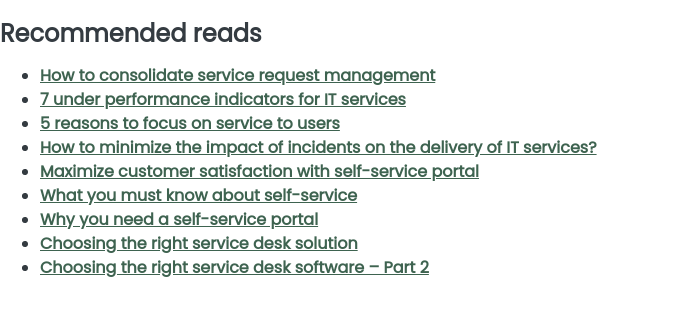Like the entrepreneur who has the flair to seize the right opportunities, intuition in Service Management or a process management context is critical and can represent the success or failure of a project. However, it is reasonable to assume that the concept of intuitiveness is constantly evolving, regardless of the field.
The ITSM Intuitive
In Service Management, new technologies influence the notion of clarity among the tools available to IT managers and their teams. Constantly looking for the best IT service and support application, these managers will generally find intuitiveness through four major aspects of their Help Desk, Service Desk or ITSM tool :
- An optimal and ergonomic application interface
- Clarified business process following the industry-recommended frameworks
- An intuitive service catalogue, easy to use, allowing an independent service consumption
- An intuitiveness that benefits internal efficiency within the organization
Optimal Interface. Prioritized UX.
The different views included in an application must be simple and clear to the user. The ergonomics and the design work should facilitate everyday actions performed through the software. As for a Service Management application, the interface must be conceived for end-users or customers and technical resources who use the application differently and through different functions. Conception work must be customized to ensure comprehensive intuitiveness for both sides.
This immediate knowledge, conceptual seizure without an intermediary, may experience through task management, simplified queries management or the management of a dynamic and evolving knowledge base. ITSM software seeks to improve the intuitiveness of all these elements, but very few can truly meet the growing needs of users. Mark my words, the user experience is proof of everything.
Framework Complexity
How to avoid the shackles that can produce full framework compliance prevalent in the ITSM industry? While these frameworks have the best general practices, we cannot subscribe to them by closing our eyes to the business processes of an organization. Whether you are a consultant, an administrator or an IT manager, know that intuitiveness begins by customizing these frameworks to your systems. Good communication between the external advice and your internal acquired ensures a certain transition. This gradual adjustment will allow you and your team to step back on the next process integration.
The complexity of frameworks can be a barrier to intuitiveness than experience on your support team. Involve stakeholders in the transition to maximize your intuitive software tools. Your daily activities will be positively impacted, even in the short term.
And the Consumption of Services in all this?
The intuitiveness is particularly materializing through the service catalogue. This virtual store with detailed, quantified and measured services is the basis of the clarity of Service Management software (ITSM). However, the real intuitiveness is felt on the self-service web portals, where consumption of continuous service occurs. In other words, the ease of use of these portals guarantees autonomy and efficiency, which can be particularly beneficial for streamlining organizational costs. This same facility can be translated into mobility portals. With the growing demand for mobility users, intuitive portals must be available via tablets and smartphones. In sum, one word defines the intuitiveness of this function: autonomy.
Do ITSM Intuitiveness and Internal Efficiency go side by side?
ITSM intuitive functions are important, but what about the real impact on the internal efficiency of a company or institution? This application must clearly reflect and serve the performance of your teams. Thus, reporting tools and relevant performance indicators are part of a series of elements in a clear Service Management vision. These intuitive tools will solve problems more quickly, reducing the time to react to certain events, enabling proactive alerts or activating automated actions. Then, do you think intuitiveness and Service Management efficiency go together?







